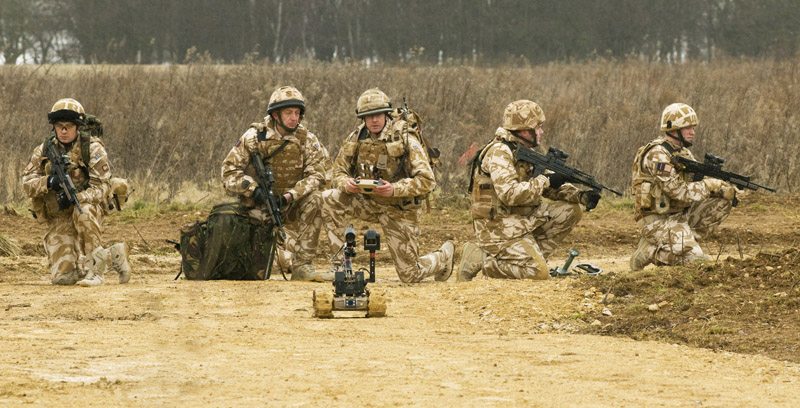The chief futurist for Cisco, Dave Evans, describes it as “The Technology Avalanche” — the exponential increase in technological breakthroughs that, like an avalanche, will disruptively and permanently change the landscape. Future “disruptive” technologies will certainly change the way we conduct war.
An excellent example of a “disruptive” technological breakthrough that has been developed over the past decade is 3D printing. This is a relatively simple procedure whereby layers of material are printed on top of one another resulting in three dimensional items from toys to car shells, and they are fully assembled at the completion of the process. Currently biotechnologists are looking at the engineering applications where organs and body parts are built using the same 3D printing techniques. In March 2011, Dr. Anthony Atala from the Wake Forest Institute for Regenerative Medicine, gave a presentation at a technology conference where he printed a 3D human kidney model on stage and explained how he is working on the technology to replace living cells as the printing matter to print a living organ. In 2009, a team of Italian and Swedish bioengineers developed the “smart hand,” the first artificial hand with feeling. In the same year, a team of Spanish researchers discovered a protein, RGS-14, which produces a near photographic memory enhancer. In June 2011, the Texas Heart Institute developed a reliable artificial heart with no clogs or breakdowns.
As humans accept more and more technologies to repair or replace unhealthy tissue, futurist Ray Kurzweil predicts that at some point in time man and machine will merge to become a new species, dubbed “singularity.” Kurzweil forecasts that in the 2030s nanobots will expand our minds through the merger of biological and nonbiological, or “machine,” intelligence. Many, including Evans, are not fully convinced about “singularity,” but other futurists find the concept plausible. Regardless of how far we trend toward singularity, the moral impacts and related decisions will be profound — particularly in the realm of warfare.
Historically, we have seen how the rapid advances made during the 2 decades between the Spanish-American War (1898) and the end of World War 1 (1918) changed the way war was conducted. The new technological advances in aircraft, tanks, submarines, battleships, artillery, machine guns, poison gas, flame throwers, and high explosives had permanent effects. The upcoming decade of technological advances in genetics, nanotechnology, and robotics will do the same in our lifetime, and the impact on warfare will be tremendous.
Evans maintains that by 2050, $1,000 worth of computing power will equal the processing power of all human brains on earth. His predictions for the next 40 years are based on the notion that the rate of technology innovation is accelerating faster than most estimations. The exponential growth in computing power, data storage, bandwidth, and information are almost unimaginable. He considers the possibility of “smart dust,” which will connect everything to the Internet, making it possible to monitor and manage our environment. Language barriers will disappear as computers enable instantaneous interpretation. Computers will possess not only exponential cognitive abilities relative to humans, but will also be “self-aware.” Like Kurzweil, some futurists are convinced that many humans will eventually accept electronic enhancements, enabling the brain to connect with the cloud and hence become more competitive for jobs. This eventuality will have a profound impact on the military as people, in addition to machines, will become increasingly susceptible to cyber attacks.
Our strategists are currently thinking about this in general terms. As the current Joint Operational Environment document points out: “In many ways the world of 2030 could appear nearly as strange to us today as the world of 2000 would have to an observer from 1900.”[1] Most futurists see this as a reality. Certainly this “avalanche” of emerging technologies will have an enormous impact on the way we conduct future wars.
Evans has presented research which he calls the “Internet of things” where he points out that at some time in 2008, more “things” became connected to the Internet through the use of a computer than there are humans connected to the Internet. These “things” are everything from sensors to automobiles to cows, which for example have their health monitored. From a military perspective, imagine an environment where “things” are trying to defeat other “things” over the Internet. Imagine an environment where the computer itself then gives the recommended course of action to the commander. Humans can develop trust in one another and varying levels of trust within staff sections. How will future commanders react when it is time to make a critical decision between conflicting advice from a computer versus an analysis from the collective intuition of a staff?
We have, as a learning institution, begun to think “outside of the box.” Perhaps it is now time to start thinking outside of the room, and then outside of the building. Even though we do not know exactly how the upcoming “Technology Avalanche” will change our world, we can be certain that our future leadership must be ready to deal with scenarios that we cannot even comprehend today.
Endnote
1. Joint Operating Environment, Washington, DC: U.S. Joint Forces Command, 2010, p. 62.
The views expressed in this op-ed are those of the author and do not necessarily reflect the official policy or position of DefenceTalk.com.
Republished with permission of the Strategic Studies Institute Newsletter, U.S. Army War College.










